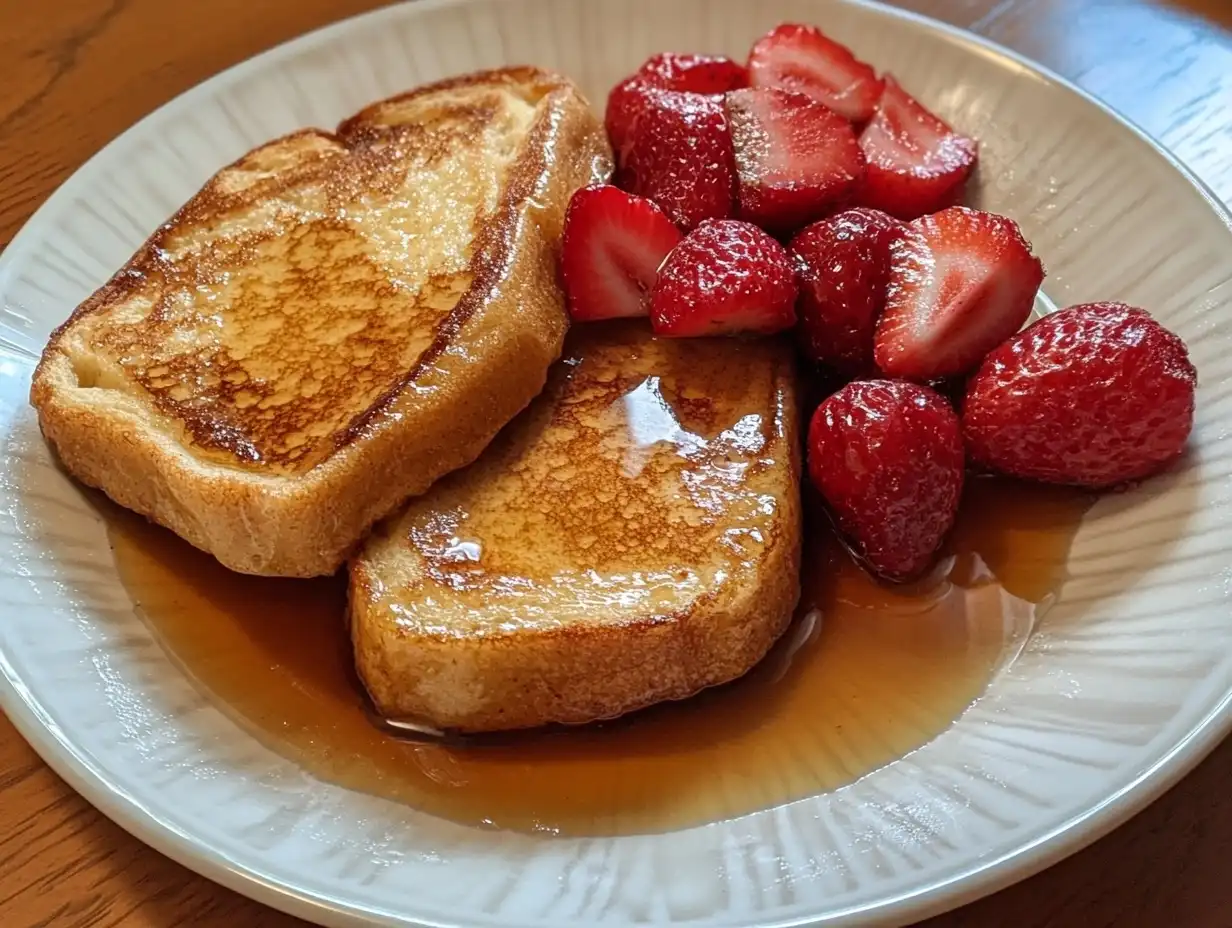A Toast to Tradition – Why I Love Sourdough French Toast
Growing up in a kitchen filled with the comforting aromas of cinnamon and butter, I learned early on that food is more than fuel—it’s love served on a plate. Now as a mom of two, I try to recreate those warm memories with recipes that are easy, delicious, and full of character—just like this Sourdough French Toast.
Sourdough, with its slightly tangy profile and hearty texture, elevates a humble breakfast into a French-inspired treat that works equally well on a crisp winter morning or a sunny weekend brunch. It’s a dish that welcomes creativity and doesn’t mind sticky fingers or second helpings.
Ingredients – Simple, Wholesome, and Pantry-Friendly
Here’s what you’ll need to serve 4 people (but trust me, you might want to double it if your kids love seconds like mine do):
Main Ingredients:
- 8 slices of sourdough bread (preferably a day or two old)
- 4 large eggs
- 1 cup whole milk (or your favorite plant-based option)
- 1/4 cup heavy cream (optional, for richness)
- 1 tablespoon sugar (or maple syrup for a natural twist)
- 1 teaspoon pure vanilla extract
- 1/2 teaspoon ground cinnamon
- 1/8 teaspoon ground nutmeg (adds a subtle warmth)
- Pinch of salt
- Butter or oil for frying
Optional Toppings:
- Fresh berries (blueberries, strawberries, raspberries)
- Maple syrup or honey
- Whipped cream
- Powdered sugar
- Nut butter or chocolate drizzle
Step-by-Step Instructions – Let’s Make Magic
Step 1: Prep the Batter
In a large mixing bowl, whisk together the eggs, milk, cream (if using), sugar, vanilla, cinnamon, nutmeg, and salt. Make sure it’s well-combined and slightly frothy.
Step 2: Soak the Bread
Place your sourdough slices into a shallow dish. Pour the egg mixture over them and let them soak for about 2-3 minutes per side. Sourdough is sturdy, so don’t worry—it won’t fall apart.
Step 3: Heat the Pan
Heat a skillet or griddle over medium heat and melt a generous pat of butter (or oil if you prefer). You want a nice sizzle when the bread hits the pan!
Step 4: Cook to Golden Perfection
Place the soaked bread on the skillet and cook for about 3-4 minutes per side, or until beautifully golden brown and slightly crisp on the edges.
Serving Ideas – Make It Yours
One of the best things about this dish? You can serve it hot off the pan with a pat of butter and drizzle of syrup, or let your family top it however they love.
Here are some family-favorite combos:
- Berry Bliss: Top with strawberries and blueberries, a little honey, and fresh mint.
- Classic Comfort: Butter, maple syrup, and a light dusting of powdered sugar.
- Nutty Banana Delight: Almond butter, banana slices, and a sprinkle of cinnamon.
- Choco-Berry Craze: Chocolate sauce, raspberries, and whipped cream (weekend treat!).

Why It’s Great for Every Season
Summer Twist
In summer, serve your sourdough French toast with a medley of fresh fruit—think juicy peaches, ripe mango, and vibrant berries. A dollop of Greek yogurt or a scoop of vanilla ice cream makes it a brunch showstopper on hot days. Add a mint sprig and iced coffee on the side, and voilà—sunshine on a plate.
Winter Comfort
When it’s chilly out, I love to warm the maple syrup and serve the toast with caramelized apples or pears spiced with cinnamon and cloves. You can even sprinkle chopped nuts or granola for that cozy crunch. It’s comfort food at its finest, especially with a steaming cup of cocoa or chai.
Tips & Tricks from a Mom Who’s Been There
- Use slightly stale bread – It soaks up the custard without turning mushy.
- Preheat your skillet well – This gives you that beautiful, crispy edge.
- Go dairy-free? – Use almond milk and skip the cream. Add coconut cream for a tropical note!
- Batch cooking tip – You can make a big batch and freeze extras. Just pop them in the toaster for a quick weekday breakfast.
- Let the kids help – Mine love dipping the bread and choosing toppings. It gets them excited to eat it too!
Making It a Family Affair – Cooking with Kids
As a mom, one of my favorite weekend rituals is having my little ones join me in the kitchen. This recipe is perfect for getting kids involved:
- Little hands can whisk the eggs and mix the custard.
- Topping station fun: Lay out bowls of fruit, syrup, and toppings so your kids can customize their toast.
- Sneaky nutrition: Add a spoonful of ground flax or chia to the batter for a hidden health boost.
Not only does this teach them kitchen confidence, but it also makes them more excited to try what they helped make. And yes, there might be a little mess—but that’s part of the joy!
A French-Inspired Classic with Your Own Signature
This dish may have roots in French cuisine—often called “pain perdu” or “lost bread,” meant to rescue stale slices—but it’s endlessly adaptable. You can:
- Use cinnamon-raisin sourdough for a built-in flavor twist.
- Add orange zest to the custard for a citrusy aroma.
- Swap vanilla for almond extract for a nutty undertone.
Whether you’re honoring tradition or adding your own flair, Sourdough French Toast is a canvas for creativity. And when it’s made with love and laughter, it becomes a memory more than just a meal.
Meal Prep & Make-Ahead – A Busy Parent’s Dream
Mornings can be wild, right? Whether it’s getting the kids dressed or packing lunches, a little breakfast prep can save the day.
Here’s how to prep your sourdough French toast ahead:
- Make a large batch on the weekend – Let them cool, then stack with parchment paper between each slice and freeze.
- Reheat in the toaster or oven – This keeps them crispy without drying them out.
- Freeze extra custard – Store in a mason jar and refrigerate for up to 2 days or freeze in an ice cube tray for individual portions.
This approach helps you keep breakfast stress-free while still offering something homemade and hearty. And the best part? Your kitchen still smells amazing on a Monday morning!
Share Your Toast Story – Connect & Create Together
Food has this magical way of connecting people. I’d love for this recipe to become part of your family’s kitchen moments, just like it has in mine.
So here’s my little mom-to-mom call to action:
Try it this weekend. Get flour on your kids’ cheeks. Let the syrup drip. Snap a pic and share your version with me on social media or in the comments—because your twist might just inspire someone else!
Cooking isn’t just about feeding. It’s about bonding, exploring, and building sweet traditions. This sourdough French toast recipe is more than a meal—it’s a memory in the making.

